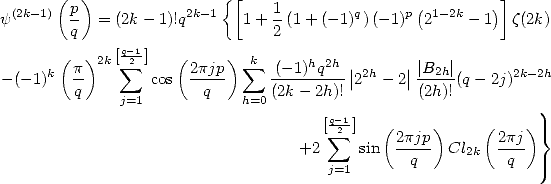|
The world of Pi - V2.57 modif. 13/04/2013 |
|
|
|
9 Polygamma and Clausen
(case  fixed integers,
fixed integers,  ,
,  )
)
An other look at the particular case of the
function  ... We are starting to corner the problem !
... We are starting to corner the problem !
9.1 Polygamma Functions
The polygamma functions are defined for  by the following relation :
by the following relation :
 |
(307) |
So we are dealling with hypergeometric series :
 |
(308) |
We'll notice that for  ,
the serie is not convergent, which is why we can use this definition.
,
the serie is not convergent, which is why we can use this definition.
However, if I've introduce the polygamma after
their series is to make the link with what interest us here, we need to
know that the usual definition of the polygamma are done using the
famous Gamma function  . Hence
the
. Hence
the  functions are in fact the
functions are in fact the  -th
differention of the logarithm of the Gamma function :
-th
differention of the logarithm of the Gamma function :
 |
(309) |
and we can define  which we also call
the Digamma function. Why are we doing that by the way?
which we also call
the Digamma function. Why are we doing that by the way?
In fact, I started from the nice formula
recalling the function  but it seems useful to quickly show why this
is all linked to the function
but it seems useful to quickly show why this
is all linked to the function  .
Because, this famous hypergeometric serie gives most of the time only
.
Because, this famous hypergeometric serie gives most of the time only  ,
even if it is hidden !
,
even if it is hidden !
Let us start from the well know equality  to confirm and remind us that the definition of
Pochammer's symbol gives us for all
to confirm and remind us that the definition of
Pochammer's symbol gives us for all  in
in 
 |
(310) |
giving the following formula
 |
(311) |
Thanks to the never the less famous
equivalence by Stirling extend to the non-integer factorial we have for
 near infinity
near infinity
 |
(312) |
by decomposing and sorting the  .
Then, we notice that
.
Then, we notice that  and that
and that  and finaly that of course
and finaly that of course  thanks
to Stirling. This leads us to
thanks
to Stirling. This leads us to
 |
(313) |
or
 |
(314) |
This gives us the logarithmic form of the Gamma function
 |
(315) |
which is equivalent to the formulation of the
function by the infinite product of Weierstrass for friends. In fact,
by taking into account that  ,
we can write
,
we can write
From there, we can go in crazy direction (which will keep quiet the rigourous justification because we don't want to overload the page) and easily find the polygamma and digamma functions commonly defined. In fact the first diffirentiation gives
 |
(317) |
then a second differentiation gives
 |
(318) |
and so on.
Basicly, you've understood it, here we are playing with the Gamma function and it's derivatives.
9.2 The digamma function
We have seen the definition of the digamma
function above (317).
It is only interesting in the fact that it involves some  and some
and some  , it does not manage to associate the Euler's gamma
constant. Hence, we get
, it does not manage to associate the Euler's gamma
constant. Hence, we get
 |
(319) |
 |
(320) |
From the formula 317,
the constant  is simplified... We need to establish if this constant
is homogeneous or not to
is simplified... We need to establish if this constant
is homogeneous or not to  or
or  ? it's likely... According to
the polygamma and the BBP formulae, we can say that if
? it's likely... According to
the polygamma and the BBP formulae, we can say that if  of
order 1 and
of
order 1 and  is of oder 2, then
is of oder 2, then  is of order
”
is of order
” ”
or below 1 in all cases...
”
or below 1 in all cases...
At the rational points, the digamma function reveals it's intimacy thanks to the theorem on Gauss' digamma, which say that
![( ) ( ) [12( sum q-1)] ( ) ( ( ))
y0 p = -g - ln(2q)- p-cot pp- + 2 cos 2pjp ln sin jp-
q 2 q j=1 q q](../mathematiciens/huvent/hyperg985x.gif) |
(321) |
for  ,
,  .
.
We clearly see here the intervention of  ,
always present in important places !
,
always present in important places !
9.3
Polygamma of order 
Plouffe but in
evidence on his page
numerous relation between the polygamma function of order  and the constants of order
and the constants of order  for rational parameters.
for rational parameters.
9.3.1 Link with the integrals of BBP formulae
Even if those relation were only put to light
later on, they are nothing less than BBP formula with no powers  . In fact, this comes down
to taking a particular integral, and more precisely
. In fact, this comes down
to taking a particular integral, and more precisely  in the formula 64.
in the formula 64.
 |
(322) |
For this reason, the proof of those formulae are done exactly done the same as in the paragraph dedicated to BBP formulae.
9.3.2 A graphical approach
Plouffe approached
the linear relations from an other angle than that of classical
formulae, it's the linear link. In fact, by systematically searching
for relations for the polygamma of order  taken with rationals values with some small denominators, we can
constuct some schema synthetising the link between polygamma of the
same order. We just need to follow the path of the line to observe
which constant are linearly link between them.
taken with rationals values with some small denominators, we can
constuct some schema synthetising the link between polygamma of the
same order. We just need to follow the path of the line to observe
which constant are linearly link between them.
Concerning notation, we'll notice that the
differentiation of the digamma function is the polygamma function of
order 2 :  to understand Plouffe's notation.
to understand Plouffe's notation.
A first example is given with the constants  and
and  (Catalan's constant) which is of order 2 as everyone
knows :
(Catalan's constant) which is of order 2 as everyone
knows :

|
Here, we need to understand that the circuit
between  ,
,  , and
, and  is closed since they form a triangle. Hence numerically,
we have in fact
is closed since they form a triangle. Hence numerically,
we have in fact
 |
(323) |
As Plouffe said it,
note that if we introduced  , we would most likely find other diagrams of other
branches of existing diagrams.
, we would most likely find other diagrams of other
branches of existing diagrams.
I also take his commenteries, only common
sense, which indicates for example on the diagram we can not apparently
find relations in  between
between  ,
,  ,
and
,
and  , but nothing say about it's validity
in other domains, in fact with
, but nothing say about it's validity
in other domains, in fact with  or other things of the kind.
or other things of the kind.
The symetry that appears in this scheme (and sometime others) is often due to analytical formula of symetry, here for example, we have
 |
(324) |
which gives a lot of rational relations at
least for  .
.
Finaly, a few liasion between rationals
polygamma without  or
or  are not recopied here, so to avoid some confusions in the diagrams.
are not recopied here, so to avoid some confusions in the diagrams.
Here are the other diagrams build by Plouffe :
Order 2
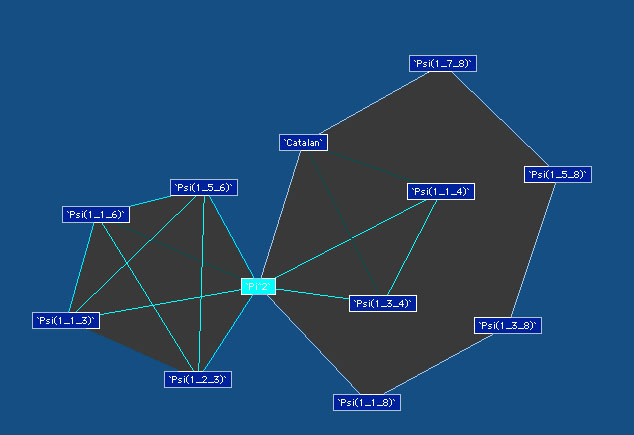
|
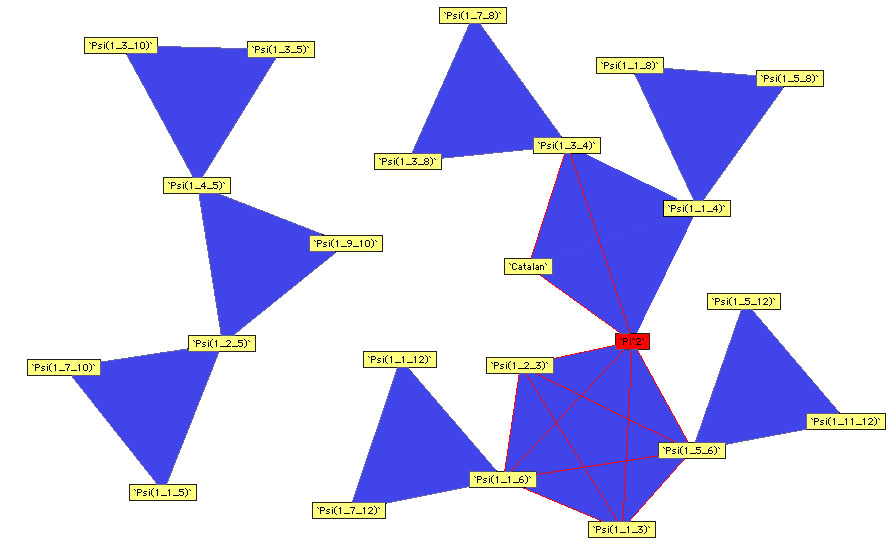
|
Ordre 3
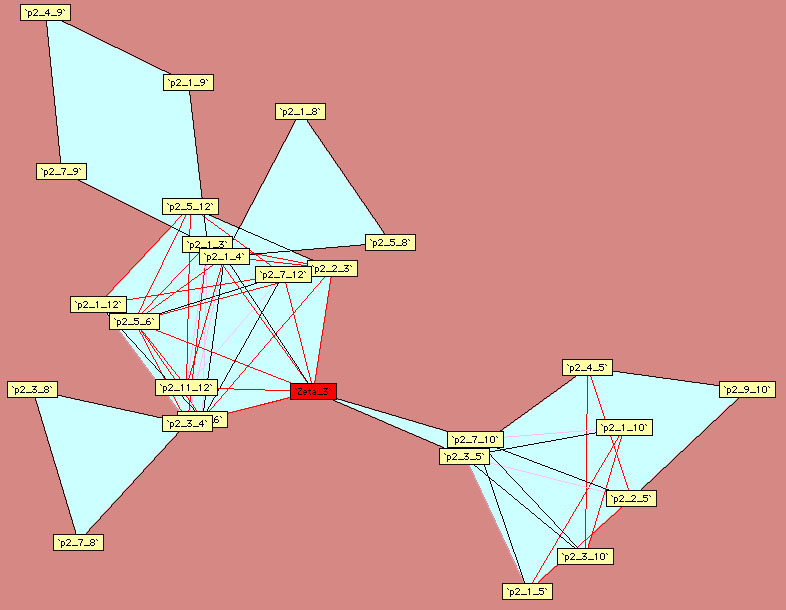
|
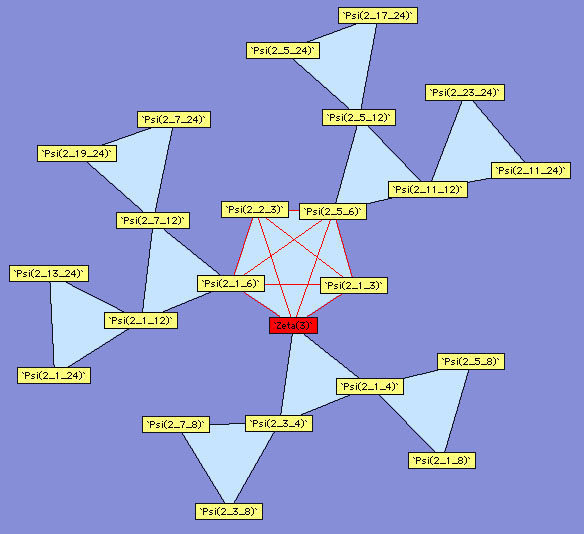
|
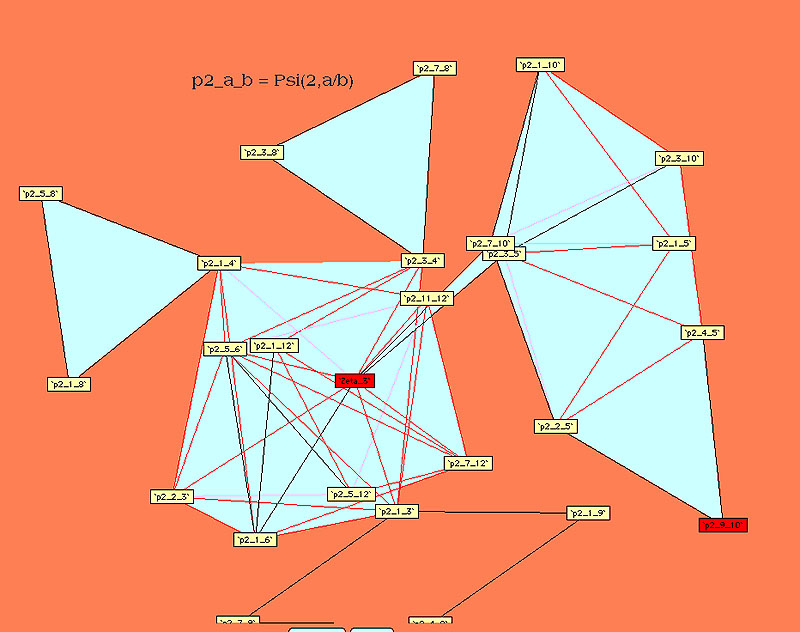
|
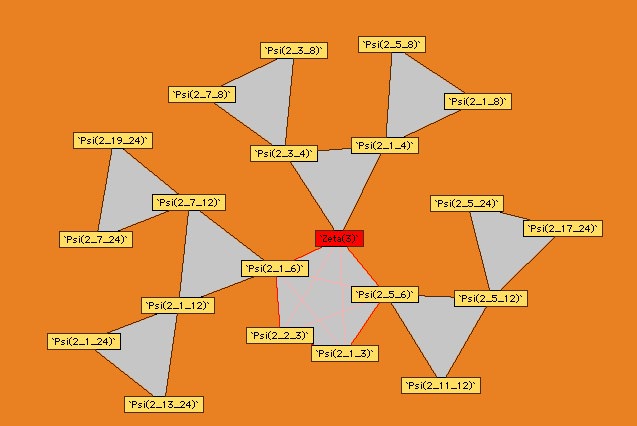
|
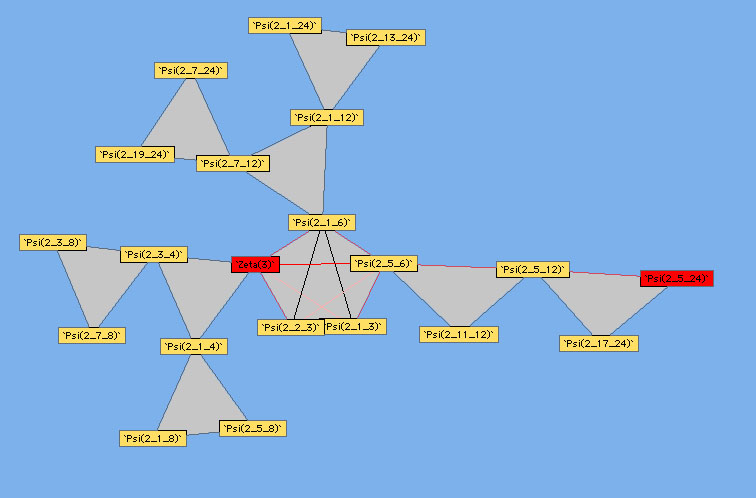
|
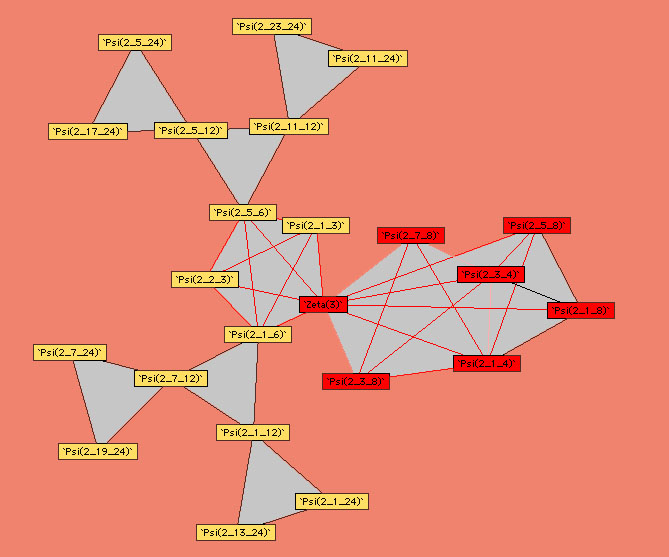
|
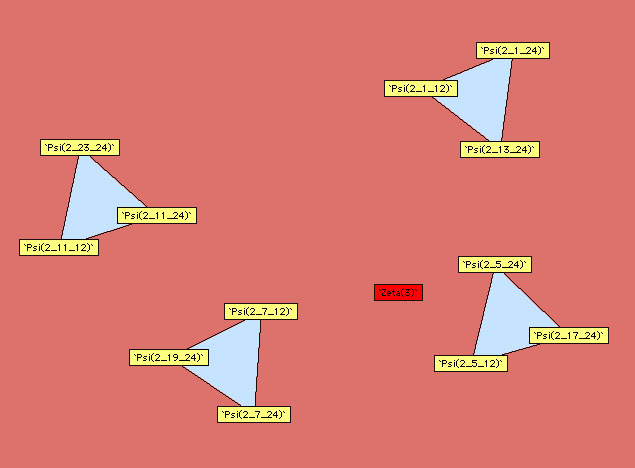
|
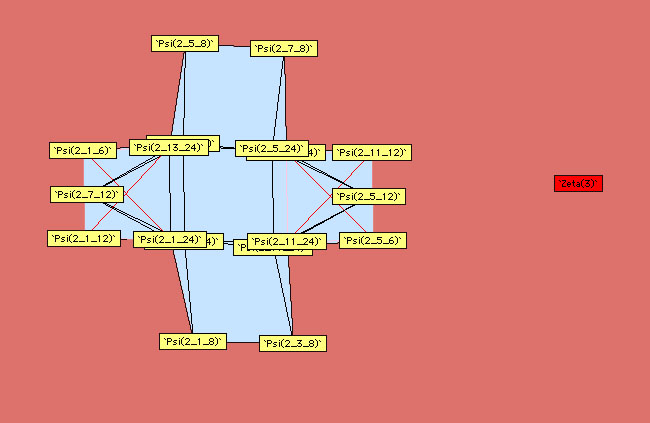
|
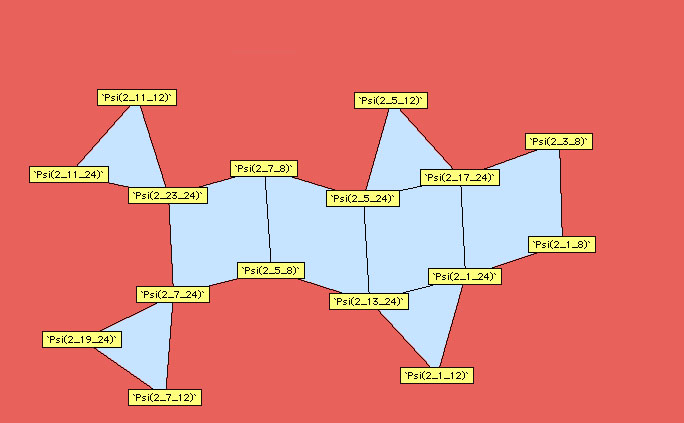
|
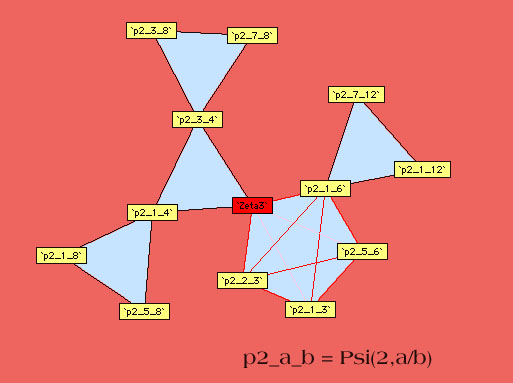
|
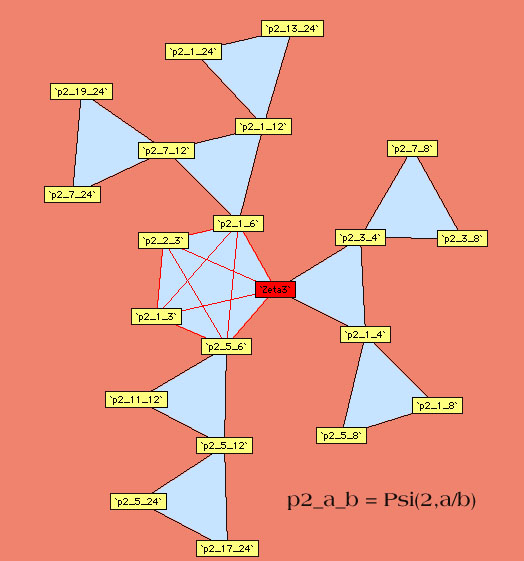
|
9.3.3 Analytical translation
Here are a few example of relation, where we
see even the dilogarithm appear! We can find the set of relations
discovered by Plouffe on this page
and surf through the sections dedicated to Euler's gamma constant, or  ,
etc...
,
etc...
Order 2
 |
(325) |
 |
(326) |
 |
(327) |
 |
(328) |
 |
(329) |
 |
(330) |
 |
(331) |
 |
(332) |
 |
(333) |
Order 3
 |
(334) |
 |
(335) |
 |
(336) |


among others...
Proof Here is the proof af a formula, for example :
The most well know must be
 |
(337) |
Proof. The
proof here uses the serie and the integral representation. We can
already note that
according to the equivalent integral form (see 322), or in equivalent serie
 |
(339) |
The right hand side is the definition of
Catalan's constant .
For the lest hand side, two option are possible, we can either go
through the integral forms to find well known dilogarithms
.
For the lest hand side, two option are possible, we can either go
through the integral forms to find well known dilogarithms
We can also see all of this more directly by manipulating Euler's serie
 |
(341) |
by cutting the serie among the even and the odd, i.e.
 |
(342) |
From here, we have  and the said
relation _
and the said
relation _
This kind of easy but characteristic is found in all relations of this section. We mess around with the serie, or we go back to the integrals (or a mixture of the two). It's often easier than for the BBP formulae strictly speaking because the cconsidered integral is always between 0 and 1 (in it's usual form)
9.4 Kölbig's
combination
A powerful approach comes from a promotor article by K.S. Kölbig [15] who puts in relation the polygamma and Clausen functions. A little demonstration needs to be done !
9.4.1 Clausen's Functions
Clausen's functions are defined by series which already seems interesting !
 |
(343) |
We have in fact straight away
The asymetry of the definition (why not
consider  ?) comes from the fact that for
opposite parities, the formulae can only be calculated explicitely by
diverse classical method of integration and analysisp... For example,
we have
?) comes from the fact that for
opposite parities, the formulae can only be calculated explicitely by
diverse classical method of integration and analysisp... For example,
we have
 |
(345) |
or even
 |
(346) |
It's a lovely mathematical problem to
understand why it does not work so well in both cases! It's a similar
problems to the one that concern the odd and even values of Riemann's
function  .
.
A classical result (since there exist some !) is that
 |
(347) |
which is a good way to link those two constants !
Clausen's functions are know that they can be
express in functions of known constant uniquely for a little number of
the value of  . Which is not very interesting normaly...
But we are going to see that by using the polygamma functions, we can
sometime links them to something else !
. Which is not very interesting normaly...
But we are going to see that by using the polygamma functions, we can
sometime links them to something else !
9.4.2 Kölbig's results.
Introduction To come to Kölbig's result, we can first of all notce that an integration gives
 |
(348) |
by decompostition of the fraction in simpler
elements. The relation is valid for  . It's an other way to look at the BBP formulae, without
no interest since in the demonstration, we are going to see for example
that the nature of those constant that intervin are not determined by
the coefficient
. It's an other way to look at the BBP formulae, without
no interest since in the demonstration, we are going to see for example
that the nature of those constant that intervin are not determined by
the coefficient  ,
it being a simple weighting in front of the logarithm. It is said that
the relation is thanks to Jensen and can be found by developing the
logarithm ! Me, I don;t see
where the difficulty was by passing through the decomposition in simple
elements, but I could be wrong ?
,
it being a simple weighting in front of the logarithm. It is said that
the relation is thanks to Jensen and can be found by developing the
logarithm ! Me, I don;t see
where the difficulty was by passing through the decomposition in simple
elements, but I could be wrong ?
Then, the continuity relation by Abel allows to write that for the digamma function,
There we go.
Greater Orders In fact, Kölbig obtained very similar result, but on the differentiation on the digamma function, which we know are the polygamma. Instead of having some logarithm, we have some polylogarithm (logical!) and instead of a logarithm function of the complex exponential, we have polylog of the complex exponential, which we just know are Clausen's function according to 344 ! All of this is very coherant and gives the following Kölbig's relation
 |
(350) |
 |
(351) |
which is directly proven by the definition of
polylogarithm by summing on  :
:
 |
(352) |
We can notice that we obtain the famous
multiplication formula for the polylogarithm by letting  in this equation, it's nice !
in this equation, it's nice !
I won't go into the details of the nine page long proof in Kölbig's article by the principle is the following: Since the left hand side is real, we taje the real part of the right hand side and we calculate the differentiation of what appears. By considering the general inverse relation, and by using the fact that
kq2k |2k | |B2k| n-2k
Ln e q + (-1) Ln e q = - iq (n--2k)!| 2 -2| (2k)!(q- 2j)
k=0](../mathematiciens/huvent/hyperg1054x.gif) |
(353) |
for  ,
we finaly obtain that
,
we finaly obtain that
Theorem 15 of Kölbig
For  ,
,  ,
,
and the even orders, for
 ,
,  ,
,
where  is the number of Bernoulli's indice
is the number of Bernoulli's indice  .
.
Some applications Above (342), we have showed that
 |
(356) |
but we can also note that we have
 |
(357) |
which allows us to obtain the values for  and
and  from the recursion formulae
from the recursion formulae
 |
(358) |
and with some thinking
 |
(359) |
but the main interest in those formulae is to
give some values for  ,
,  ,
,  ,
,  in function of well known constants ! For
in function of well known constants ! For  ,
,
We hence find the relations (325), (331), (332), (335) and (336) given by Plouffe .
back to home page






